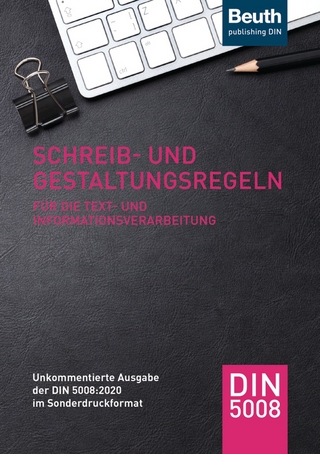
Writing: Ten Core Concepts (w/ MLA9E Updates)
Wadsworth Publishing Co Inc (Verlag)
978-0-357-50565-6 (ISBN)
- Titel z.Zt. nicht lieferbar
- Versandkostenfrei innerhalb Deutschlands
- Auch auf Rechnung
- Verfügbarkeit in der Filiale vor Ort prüfen
- Artikel merken
Robert P. Yagelski is associate vice provost and director of the Program in Writing and Critical Inquiry and professor of English education in the Department of Educational Theory and Practice at the State University of New York (SUNY) at Albany. He teaches courses in writing, composition theory and pedagogy, critical pedagogy and qualitative research methods in addition to helping prepare secondary school teachers. Considered a leading voice in composition theory, Dr. Yagelski is widely published in the major journals in the field. He is former director of the Capital District Writing Project, a site of the National Writing Project, and former director of the SUNY-Albany Writing Center. He earned his Ph.D. in rhetoric and composition from The Ohio State University.
Part I: A GUIDE TO WRITING EFFECTIVELY.
1. Why We Write.
Understanding Writing. Writing in College. Writing in the Workplace. Writing as a Citizen. Writing to Understand Ourselves.
2. Ten Core Concepts for Effective Writing.
Core Concept 1: Writing Is a Process of Discovery and Learning. Core Concept 2: Good Writing Fits the Context. Core Concept 3: The Medium Is Part of the Message. Core Concept 4: A Writer Must Have Something to Say. Core Concept 5: A Writer Must Support Claims and Assertions. Core Concept 6: Purpose Determines Form, Style, and Organization in Writing. Core Concept 7: Writing Is a Social Activity. Core Concept 8: Revision Is an Essential Part of Writing. Core Concept 9: There Is Always a Voice in Writing, Even When There Isn't an I. Core Concept 10: Good Writing Means More Than Good Grammar.
3. The Ten Core Concepts in Action.
Step 1: Discover and Explore a Topic. Step 2: Examine the Rhetorical Context. Step 3: Select an Appropriate Medium. Step 4: Have Something to Say. Step 5: Back Up What You Say. Step 6: Establish a Form and Structure for Your Project. Step 7: Get Feedback. Step 8: Revise. Step 9: Strengthen Your Voice. Step 10: Make It Correct.
4. A Student Writer Applies the Core Concepts.
Step 1: Discover and Explore a Topic. Step 2: Examine the Rhetorical Context. Step 3: Select an Appropriate Medium. Step 4: Have Something to Say. Step 5: Back Up What You Say. Step 6: Establish a Form and Structure for Your Project. Step 7: Get Feedback. Step 8: Revise. Step 9: Strengthen Your Voice. Step 10: Make It Correct. Chloe Charles' Final Draft: Why Is College So Important in the United States?"
Part II: WRITING TO ANALYZE.
5. Understanding Analytical Writing.
Occasions for Analytical Writing. Understanding Analytical Writing in College. Doing Analysis. Features of Analytical Writing. �Why Are People Who Use Illegal Drugs Demonized?� by Gideon Lasco. .
6. Examining Causes and Effects.
Occasions for Causal Analysis. Understanding Causal Analysis. Reading Causal Analysis. " Pandemics and Social Capital: From the Spanish Flu of 1918-19 to COVID-19," by Arnstein Aassve, Guido Alfani, Francesco Gandolfi, and Marco Le Moglie. " Is It Even Possible to Connect �13 Reasons Why� to Teen Suicide?," by Emily Lund. " The Roots of Schizophrenia: The Effects of Growing Up with a Schizophrenic Parent," by Mehr Sharma. Writing Causal Analysis. Writing Projects.
7. Comparing and Synthesizing.
Occasions for Comparing and Synthesizing. Understanding Comparison and Synthesis. Reading Comparative Analysis. " Online Learning during the COVID-19 Pandemic," by Yoshiko Iwai. "The Whole Truth," by Julian Baggini. "Sherlock Holmes Can Teach You to Multitask," by Maria Konnikova. Writing Analysis Involving Comparison and Synthesis. Writing Projects.
8. Conducting Rhetorical Analysis.
Occasions for Rhetorical Analysis. Understanding Rhetorical Analysis. Using Classical Rhetorical Theory for Rhetorical Analysis. Analyzing Images. Reading Rhetorical Analysis. " How DC Mayor Bowser Used Graffiti to Protect Public Space," by Rebekah Modrak. " Earthrise: A Photo That Changed the World," by Simon Torok et al. " Rhetorical Analysis of Cameron Russell�s Speech
�Looks aren�t everything. Believe me, I�m a model,�," by Kayla Ferderigos. Writing Rhetorical Analysis. Writing Projects.
9. Analyzing Literary Texts.
Occasions for Analyzing Texts. Understanding Textual Analysis. Reading Textual Analysis. "More Than an Elephant in the Room: An Analysis of Hemingway�s �Hills Like White Elephants,''' by Natalie Huebel. "Dangerous Illusions," by Caetlin Benson-Allott. "Watchmen and the Birth of Respect for Graphic Novels," by Karl Allen. Writing Textual Analysis. Writing Projects.
10. Evaluating and Reviewing.
Occasions for Evaluating and Reviewing. Understanding Reviews and Evaluation. Reading Reviews. " Psycho at 60: The Enduring Power of Hitchcock�s Shocking Game-Changer," by Scott Tobias. "Review of Destiny," by Trace C. Schuelke. "Review of Thirteen Reasons Why by Jay Asher," by Bryan Gillis. Writing Reviews. Writing Projects.
Part III: WRITING TO PERSUADE.
11. Understanding Argument.
Occasions for Argument. Understanding Argument in College. Making Arguments. Developing a Main Argument. Considering the Rhetorical Situation. Making a Persuasive Appeal. Appraising and Using Evidence. Structuring an Argument. Features of Argument. " In Higher Education, the Wand Chooses the Wizard," by Andre Perry.
12. Making Academic Arguments.
Occasions for Academic Argumentation. Understanding Academic Argument: A Case Study. Reading Academic Arguments. "Crime and Punishment," by Bruce Western. "Fulfilling Her Mother's Dream," by Patricia McGuire. " The Skinny Truth: Why Government Intervention is Necessary," by Caroline Veldhuizen. Writing Academic Arguments. Writing Projects.
13. Making Arguments in Public Discourse.
Occasions for Academic Argumentation. Understanding Argument in Public Discourse. Reading Public Arguments. �Trigger Warnings Don�t Hinder Freedom of Expression: They Expand It,� by Lindy West. �Speech at the United Nations Climate Action Summit 2019,� by Greta Thunberg. �Immigration in the Long Run: a Mutually Beneficial Process,� by Thu Hoang. Writing Arguments in Public Contexts. Writing Projects.
14. Presenting a Proposal.
Occasions for Writing Proposals. Understanding Proposals. Reading Proposals. �University of California Student Investment Proposal,� by Fix UC. �Puppies Behind Bars,� by Annie Teillon. �Proposal to Reduce the National Drinking Age,� by Choose Responsibility. Writing Proposals. Writing Projects.
PART IV: WRITING TO NARRATE AND INFORM.
15. Understanding Narrative Writing.
Occasions for Narrative. Understanding Narrative Writing in College. Telling Stories. Features of Narrative. �The Art of Butchery,� by Amanda Giracca.
16. Writing Personal Narratives.
Occasions for Personal Narrative. Understanding Personal Narrative. Reading Personal Narrative. �The Balancing Act,� by Haley Lee. �Some Thoughts on Mercy,� by Ross Gay. �My Brother Caleb,� by Libra Dolce. Writing Personal Narratives. Writing Projects.
17. Writing Literacy Narratives.
Occasions for Literacy Narrative. Understanding Literacy Narrative. Reading Literacy Narrative. �Reading, Writing, and Feeling,� by Nicholas Johnson. �Swimming Through Writer�s Block at an Icelandic Public Pool,� by Amanda Whiting. �Listening to Hear,� by Yasmin Zacaria Mikhaiel. Writing Literacy Narratives. Writing Projects.
18 Writing Informative Essays.
Occasions for Informative Writing. Understanding Informative Writing. Reading Informative Writing. �Gamification: How Competition is Reinventing Business, Marketing, and Everyday Life,� by Jennifer Van Grove. �The Nature of Our Nature,� by Anna Lapp�. �Perspective from the Field: Illegal Puppy Imports Uncovered at JFK Airport,� by Molly K. Houle. Writing Informative Essays. Writing Projects.
PART V: ESSENTIAL READING AND RESEARCH SKILLS.
19. Reading for Understanding and Engagement.
Understanding Academic Writing as Conversation. A Strategy for Reading Academic Texts. Critical Reading. Summarizing and Paraphrasing. Synthesizing.
20. Writing Summary-Response Essays.
Occasions for Summary-Response Writing. Understanding Summary-Response. Writing a Summary-Response Essay.
21. Finding Source Material.
Understanding Research. Determining What Your Need. Understanding Sources. Locating the Right Sources. Developing a Search Strategy.
22. Evaluating Sources.
Determining Whether a Source is Trustworthy. Evaluating Source Material for Your Rhetorical Purposes.
23. Using Source Material.
Quoting From Sources. Additional Guidelines for Quoting From Sources. Avoiding Plagiarism.
24. Preparing an Annotated Bibliography
Features of Annotated Bibliography. Creating a Bibliographic Citation. Writing Annotations. Writing an Annotated Bibliography.
25. Citing Sources Using MLA Style.
Two Main Components in MLA Style. Creating In-Text Citations in MLA Style. Creating a Works Cited List in MLA Style. Sample MLA-Style Research Paper: �An Analysis of the Research on the Prevalence and Perpetuation of Emotional Abuse in Relationships,� by Olivia Thomas.
26. Citing Sources Using APA Style.
Two Main Components in APA Style. Creating In-Text Citations in APA Style. Creating a References List in APA Style. Sample APA-Style Research Paper: �U.S. Foreign Policy on Religious Persecution,� by Nazafat Jarrin.
27. Designing Documents.
Understanding Document Design as a Rhetorical Tool. Principles of Document Design. Working With Visual Elements. Designing Documents: Two Sample Projects.
28. Creating Presentations.
Principles for Developing Presentations. Making Oral Presentations. Using Presentation Software. Virtual and Multimedia Presentations. A Sample Presentation.
29. Composing With Style.
Developing an Academic Writing Style. Writing Paragraphs. Framing. Introductions. Transitions.
30. Avoiding Common Problems in Grammar and Usage.
Strategies for Avoiding Errors. Coordination, Subordination, and Parallelism. Common Sentence-Level Problems. Common Pronoun Errors. Word Choice and Style. Common Punctuation Errors."
| Erscheinungsdatum | 30.04.2021 |
|---|---|
| Verlagsort | Belmont, CA |
| Sprache | englisch |
| Maße | 188 x 232 mm |
| Gewicht | 1497 g |
| Themenwelt | Schulbuch / Wörterbuch ► Wörterbuch / Fremdsprachen |
| Geisteswissenschaften ► Sprach- / Literaturwissenschaft ► Literaturwissenschaft | |
| Geisteswissenschaften ► Sprach- / Literaturwissenschaft ► Sprachwissenschaft | |
| ISBN-10 | 0-357-50565-4 / 0357505654 |
| ISBN-13 | 978-0-357-50565-6 / 9780357505656 |
| Zustand | Neuware |
| Haben Sie eine Frage zum Produkt? |
aus dem Bereich


